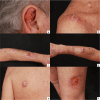Frequency of skin diseases in renal transplant recipients and patients with chronic kidney disease in a tertiary center: a cross-sectional study
- PMID: 38422240
- PMCID: PMC10885634
- DOI: 10.1590/1516-3180.2023.0148.R1.29112023
Frequency of skin diseases in renal transplant recipients and patients with chronic kidney disease in a tertiary center: a cross-sectional study
Abstract
Background: The prevalence of chronic kidney disease (CKD) has increased in the recent decades, along with the number of patients in the terminal stages of this disease, requiring transplantation. Some skin disorders are more frequent in patients with CKD and in renal transplant recipients (RTR).
Objectives: To evaluate the frequency of skin diseases in RTR and patients with CKD receiving conservative treatment.
Design and setting: This observational cross-sectional study recruited consecutive patients with CKD and RTR from a nephrology clinic at a teaching hospital in Brazil between 2015 and 2020.
Methods: Quantitative, descriptive, and analytical approaches were used. The sample was selected based on convenience sampling. Data were collected from dermatological visits and participants' medical records.
Results: Overall, 308 participants were included: 206 RTR (66.9%, median age: 48 years, interquartile range [IQR] 38.0-56.0, 63.6% men) and 102 patients with CKD (33.1%, median age: 61.0 years, IQR 50.0-71.2, 48% men). The frequency of infectious skin diseases (39.3% vs. 21.6% P = 0.002) were higher in RTR than in patients with CKD. Neoplastic skin lesions were present in nine (4.4%) RTR and in only one (1.0%) patient with CKD. Among the RTR, the ratio of basal cell carcinoma to squamous cell carcinoma was 2:1.
Conclusions: This study revealed that an increased frequency of infectious skin diseases may be expected in patients who have undergone kidney transplantation. Among skin cancers, BCC is more frequently observed in RTR, especially in those using azathioprine.
Conflict of interest statement
Figures
References
-
- Brasil . Diretrizes Clínicas para o Cuidado ao paciente com Doença Renal Crônica – DRC no Sistema Único de Saúde. Brasília: Ministério da Saúde; 2014. [Accessed in 2023 (May 8)]. Available from: https://bvsms.saude.gov.br/bvs/publicacoes/diretrizes_clinicas_cuidado_p....
Publication types
MeSH terms
LinkOut - more resources
Full Text Sources
Medical


